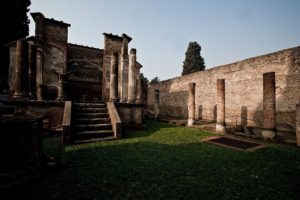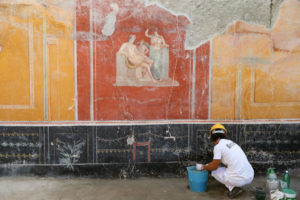This Week in History: August 21 – 27
The destruction of Pompeii is devastating, but we have learned so much from what was left behind.
By: Kelli Ballard | August 21, 2022 | 974 Words

Pompeii (Photo by Ivan Romano/Getty Images)
“I have but one lamp by which my feet are guided, and that is the lamp of experience. I know no way of judging of the future but by the past.” ~ Edward Gibbon
August 24, AD 79: Volcano Eruption Destroys Pompeii
Although it has been nearly 2,000 years since the Vesuvius volcano in southern Italy erupted, destroying the city of Pompeii, the world is still fascinated with this historical event – and still learning from it. It is so important to understanding ancient Rome and how the people lived in that time, that there was even a movie made about it in 2014, aptly titled Pompeii.
The History of Pompeii

Temple of Isis in Pompeii (Photo by Alessandra Benedetti/Corbis via Getty Images)
Considered a resort city, Pompeii was located just south of Rome along the coast of Italy, near modern day Naples. The ancient Greeks settled the area, but in the second century BC, the independent city became influenced by Rome.
The Bay of Naples was an attraction place, a getaway, for wealthy travelers from Rome. The beautiful, yet active volcano, Vesuvius, was just five miles away. The city was flourishing, and mainly rich folk lived there, although there were still peasants and even slaves as well. Its wealth came from the rich volcanic soil of the region, which was excellent for growing crops such as olives and grapes. In fact, many of Rome’s more fashionable homes served wine from Pompeii.
Along the streets were elegant houses with exceptional artwork, villas, and even fountains lined the paved roads. Aside from the shops, cafes, and bathhouses, there was also an arena that could seat 20,000 people.

(Photo by Marco Cantile/LightRocket via Getty Images)
It was seen as an idyllic place, which is why so many didn’t leave, even when the earthquakes warned of something more dangerous on its way.
The Fall of Pompeii
In the year AD 79, Mt. Vesuvius erupted. It is still an active volcano today, but in ancient Rome people didn’t know what danger it posed.
At the time of the eruption, there were about 12,000 people living in the city, and another 12,000 or so in surrounding towns. Small earthquakes had been shaking the area for a while, but many people chose to ignore them.
Then, on August 24, AD 79, just after noon, the mountain erupted. Some residents chose to leave, but others tried to weather the storm. Even when the city was covered in ash, there had still been time to escape, but people did not want to leave their paradise. By the next morning, Pompeii was covered under millions of tons of volcanic ash. No one survived.
Pompeii Today
Centuries passed before explorers, in 1748, started digging in the area and found some amazing things. It turns out, the volcanic ash that covered the city worked as a great preserver. The city was almost exactly as it had been nearly 2,000 years before.
The houses still had furniture, gold and silverware, terracotta lamps, ornaments, and even foods. The grain mills were still intact with grindstones and other tools, as were the workshops where cloths were manufactured. There were even stores with fruits and vegetables perfectly preserved. “Pompeii is one of the most significant proofs of Roman civilization and, like an open book, provides outstanding information on the art, customs, trades and everyday life of the past,” explains the city’s website. Pompeii opened a window for modern people to see what life in ancient Rome was like. It is still one of the world’s top tourist destinations today, getting about 2.5 million visitors each year.
In the 1780s, German philosopher-poet Johann Goethe toured the city ruins and wrote: “Many disasters have befallen the world, but few have brought posterity so much joy.”
Other Notable History Mentions
August 21, 1959: President Dwight D. Eisenhower signed the proclamation that admitted Hawaii to the Union as the 50th state.
 August 24-25, 1814: British forces invaded Washington, DC, during the War of 1812 and burned the Capitol, the White House, and other buildings.
August 24-25, 1814: British forces invaded Washington, DC, during the War of 1812 and burned the Capitol, the White House, and other buildings.
August 25, 1985: Samantha Smith died in a plane crash. In 1982, when she was just 11 years old, she had written a letter to Yuri Andropov, Soviet Russia’s leader, asking, “Why do you want to conquer the whole world, or at least our country?” Andropov responded personally and paid for her to visit the USSR, where she toured for two weeks and became a symbol of hope for peace for Americans and Russians.
August 26, 1883: One of the worst volcanic eruptions happened on the island of Krakatoa in Indonesia. People heard the explosions for 200 miles. Tidal waves reached 120 feet tall and killed 36,000 people on islands nearby.
Famous Birthdays
Claude Debussy (August 22, 1862) was born in Saint-Germain-en-Laye, France. He was a French composer with a unique way of playing chords that started the style of music called impressionism.

Lyndon Baines Johnson (Getty Images)
Leonard Bernstein (August 25, 1918) was born in Lawrence, Massachusetts. He is considered one of the best conductors in American history with works such as On the Town and West Side Story.
Lee De Forest (August 26, 1873) was born at Council Bluffs, Iowa. An American inventor, he was a pioneer in creating wireless radio broadcasting and television.
Charles Dawes (August 27, 1865) was born in Marietta, Ohio. He was vice president of the United States from 1925-1929, and in 1925 received the Nobel Peace Prize.
Lyndon Baines Johnson (August 27, 1908) was born near Stonewall, Texas. He became the 36th president of the US after John F. Kennedy was assassinated.
Mother Teresa (August 27, 1910) was born in Skopje, Yugoslavia. Her birth name was Agnes Gonxha Bojaxhiu. She spent her life working with the poor and sick in India and founded the Missionaries of Charity (a religious order of nuns) in Calcutta.
















